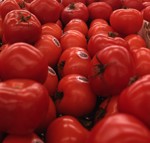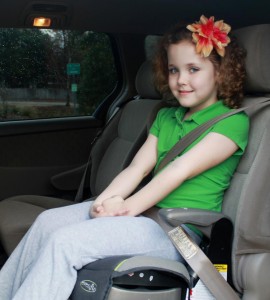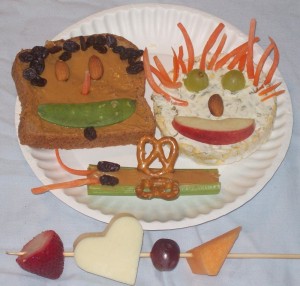by Kendra Hughson | Jul 23, 2012
Tomatoes are the most popular vegetable in backyard gardens. With each plant capable of producing 8-10 pounds of fruit or more, good gardeners may have more tomatoes than they can eat. If you lack a green thumb, tomatoes are easy to find at farmers markets, roadside stands, and even grocery stores.
Botanically, the tomato is a fruit but in 1893 the U.S. Supreme Court declared the tomato a vegetable because of a tariff dispute. Nutritionally, tomatoes are low in calories and fat and high in vitamin C and potassium. They are good source of vitamin A in the form of beta carotene. Tomatoes are also high in the antioxidant, lycopene. Research has shown that lycopene may reduce the risk of heart disease and several types of cancer. Lycopene is more easily absorbed from cooked tomato products. Eighty percent of the lycopene in the American diet comes from tomato products.
There is nothing tastier than a freshly picked tomato. Choose tomatoes that are firm, fragrant, and brightly colored. Avoid bruised tomatoes that are too soft or too hard. Store tomatoes at room temperature, and only refrigerate tomatoes to keep them longer. Fresh tomatoes are good in salads, on sandwiches, or tossed on scrambled eggs, nachos, or in other common dishes like macaroni and cheese.
Tomatoes are easy to preserve by freezing, drying, or canning.
FREEZING
Frozen tomatoes are mushy when thawed but can be used in soups and casseroles. Wash and dip tomatoes in boiling water for 30 seconds to loosen skins. Core and peel. Freeze whole or in pieces. Pack in freezer containers, jars, or packaging, leaving 1- inch headspace.
Cooked Puree. Wash, peel, core, and cut tomatoes. Cook until soft. Press through food mill or sieve. Cool and pack into freezer jars or containers. Concentrate the puree by boiling until amount is reduced in half.
Juice. Wash, core, peel, and cut tomatoes. Simmer about 5 minutes; put through a sieve or food mill. Cool and pack as above.
DRYING
Small cherry tomatoes or tomatoes with a high solid content, such as Romas, work best for drying. Dried tomatoes are good in soups, stews, sauces, and salads. Tomato leather can be eaten as is, added to soups for flavor, or a little water can be added to the leather to make a savory tomato sauce. Steam tomatoes for 3 minutes or dip tomatoes in boiling water for 1 minute to loosen skins. Chill in cold water; slip skins off. Cut into sections about 1/2 inch wide or slices; cut small tomatoes in half. Dry tomatoes in a food dehydrator for approximately10-18 hours (length of time depends on initial moisture content). Follow the manufacturer’s instructions.
CANNING
Tomatoes are a low-acid food and must be canned carefully to avoid the risk of botulism. To acidify tomatoes, add 1 tablespoon bottled lemon juice, 1/4 teaspoon citric acid, OR 2 tablespoons vinegar per pint jar. For quarts, add 2 tablespoons bottled lemon juice, 1/2 teaspoon citric acid, OR 4 tablespoons vinegar per jar. The acid can be added directly to each jar before filling with the product. Add a little sugar to offset any strong acid taste. Tomatoes can be processed using a boiling water bath or a pressure canner. Use only tested recipes and current canning recommendations from the National Center for Home Food Preservation (http://nchfp.uga.edu/).
Whole or halved raw tomatoes packed in water:
Add two tablespoons bottled lemon juice to each clean quart jar and fill with peeled, raw whole or halved tomatoes. Cover tomatoes in jar with hot water leaving ½ inch headspace. Wipe off jar rim. Adjust pretreated lids and screw ring onto jar, finger tight. Process quarts for 45 minutes in a boiling water bath. If you use a dial-gauge pressure canner, process for 10 minutes at 11 pounds pressure With a weighted gauge canner, process 10 minutes at 10 pounds pressure.
RECIPE:
Fresh Garden Salsa
The ingredients can be finely diced or use a medium chopped consistency for chunky salsa. Serve with tortilla chips or use as a side dish with grilled meat or anywhere you want a bright, tart, savory accompaniment.
2 large ripe, red slicing tomatoes, cored and chopped
1 small white onion, chopped
1 green onion, top included, chopped
1 to 3 jalapeno peppers, finely chopped
1/4 cup cilantro leaves, minced
Juice of lime
teaspoon salt
1. Using a serrated knife, chop tomatoes. If using plum tomatoes, add 2 tablespoons water.
2. In a medium bowl, toss together the tomatoes, onions, peppers, and cilantro. Squeeze lime juice over the mixture and sprinkle on the salt. Allow to rest 30 minutes before serving to allow salt to draw juice from the tomatoes. Stir again just before serving. Makes about 2 cups.
For more information about growing or preserving tomatoes or other produce, contact the UF/IFAS Leon County Extension office at 850-606-5200, or your local Extension office.
Author: Kendra Zamojski, County Extension Director and Family and Consumer Sciences Agent, UF/IFAS Leon County Extension
by Judy Corbus | Jul 6, 2012
A cold glass of milk on a hot summer day offers more than just cool refreshment. Who knew one eight-ounce glass of milk provides:
- Calcium, vitamin D, and phosphorus for strong bones and teeth.
- Riboflavin and vitamin B-12 for a healthy nervous system.
- Niacin for normal enzyme functioning.
- High-quality protein for lean muscle.
- Potassium for maintaining normal blood pressure and nerve and muscle functions.
- Vitamin A for good vision, healthy skin, and a strong immune system.
Dairy foods offer a lot of nutrition in a small package. The Dairy Group includes all liquid milk and products made with milk that retain their calcium after processing; this includes yogurt and cheese. Cream cheese, cream, and butter are not included since processing causes them to lose or reduce their calcium content, and they are high in fat and low in nutrients.
MyPlate (http://www.choosemyplate.gov/) recommends consuming two to three cups of milk or milk products every day depending on age, sex, and level of physical activity. What counts as “one cup” of dairy foods? One cup of milk, one cup of yogurt, 1 1/2 ounces ( two slices) of hard cheese (cheddar, mozzarella, Swiss, parmesan), two ounces (three slices) processed cheese (American), one cup of pudding made with milk, or 1 1/2 cups of ice cream.
Fat-free (skim) or low-fat (one percent) milk has the same nutritional value as whole or reduced-fat milk but without the saturated fat. The American Academy of Pediatrics recommends:
- Infants should drink breast milk or iron-fortified formula during their first year of life.
- Children between 1 and 2 years should drink whole milk. They do not need to limit fat, as it is needed for growth and energy.
- Children older than 2 years should drink fat-free or low-fat milk.
To add dairy foods to your meals:
- Use milk to prepare cream soups.
- Add cheese in salads, pizza, casseroles, soups, and stews.
- Use milk to prepare hot cereals.
- Use milk in your hot beverages such as lattes, cappuccinos, and teas.
- Have yogurt or cheese sticks for a calcium-rich snack.
- Use yogurt as a dressing for salads, as a topping for a baked potato, or try it mixed with fruit.
- As desserts, try low-fat ice cream, frozen yogurt, and pudding made with milk.
Lactose-intolerant individuals lack the enzyme, lactase, to digest lactose, or milk sugar. To get the necessary calcium, choose cheese, yogurt, or lactose-free alternatives. These foods also are good sources of calcium: calcium-fortified beverages, such as orange juice; canned fish (sardines, salmon with bones); soybeans and soy products; and leafy greens such as collard, turnip greens, kale, and bok choy.
Sources: Claudia Penuela, Healthy Dairy Choices for MyPlate, http://edis.ifas.ufl.edu/pdffiles/FY/FY118100.pdf.
BodybyMilk, http://www.bodybymilk.com/
Author: Judy Corbus, Family and Consumer Sciences Agent, UF/IFAS Extension – Washington and Holmes Counties
by Ginny Hinton | Jul 6, 2012

A booster seat “boosts” a child up for proper placement of the lap and shoulder belt on the lower hips/upper thighs and shoulder/collar bone.
Piper is 7 years old. She goes to school, plays with dolls, and loves to visit friends. Piper’s career goal is to take over the world through “flower power”. When Piper travels, she sits in a booster seat that makes her seat belt fit perfectly. In a crash, Piper’s seat belt will keep her in the car and distribute crash forces across the strongest parts of her body. Piper’s mom makes sure she travels safely on every trip, so that Piper can confidently pursue her plans for world dominion.
Unfortunately, Piper and her mom are the exception. Many children in elementary school need to sit in booster seats but don’t. Following the law is not enough, especially for children in Florida. Only in Florida can a 4-year-old child legally use an adult seat belt.
In a crash, poor seat belt fit can lead to serious internal injury or even death. Children who have outgrown their 5 point harness car seat by weight or height should use a booster seat until they reach approximately 4’9”, typically between the ages of 8-12. Many parents/caregivers skip this very important step and start using a seat belt much too soon, never realizing the danger in which they’re putting their child.
A booster seat “boosts” a child up for proper placement of the lap and shoulder belt on the lower hips/upper thighs and shoulder/collar bone. Without a booster, seat belts often cross over a child’s soft stomach and neck, which can lead to debilitating injuries such as a ruptured spleen, torn intestines, internal bleeding, or paralysis.
Booster seats keep children out of the hospital, saving heartache, worry and medical expenses. A $15 booster seat for a child age 4-7 yields an average savings of $2,500 per child. “Big kids” like Piper deserve to be kept safe when they travel, and booster seats help make that happen. Is your child riding safely in the car?
For more information or assistance with child passenger safety please contact Ginny Hinton at the Santa Rosa County UF/IFAS Extension Office: ginnyh@santarosa.fl.gov or 850-623-3868.
(NHTSA & Partners for Child Passenger Safety (PCPS), **(Pacific Institute for Research and Evaluation (2010 update, ‘Injury Prevention: What works?’ Special Thanks to Tamyne Maxson, Child Passenger Safety Community Coordinator, St. Joseph’s Child Advocacy Center, Tampa, FL
by Angela Hinkle | Jun 1, 2012
School’s out! One way to get creative with all this extra time and to eat nutritiously is to make and eat healthy snacks. Like an arts and crafts project, making a snack can be a great summertime activity. Bonus: the kids get to eat their artwork and you get to sneak nutritious foods into their day for a healthy diet.
Some works of art need the following elements:
- Foundation – slices of whole wheat bread, tortillas, English muffins, lettuce leaves, rice cakes, zucchini or cucumber rounds, apple or pineapple slices.
- Glue – peanut butter, low-fat cream cheese, cheese spread, hummus, refried beans, low-fat yogurt, jam, pizza sauce, or low-fat ranch dressing.
- Bling – seeds, nuts, grapes, raisins, match stick carrots, olives, beans, low-fat granola, diced fruits and veggies.
Start from the foundation and work up to the bling. Create faces, animals, or landscapes. Let the plate be your canvas. It’s a great way to try a new food or sample a food prepared in a totally different way.
For other works of art, use toothpicks, skewers, popsicle sticks, or edible pretzel rods to make shish kabobs. Cut out cheese shapes with small cookie cutters and add to the stick alternating with cut-up fruits and vegetables. Make a beautiful edible bouquet.
Kids also are more likely to enjoy new foods if they are served in fun containers. Try using mugs, champagne glasses, ice cream cones, or party hats.
Be sure to include nutritious foods from all the food groups as your artists create throughout the summer: load up on fruits and vegetables, incorporate whole grains, and go lean on the dairy and protein.
No sitting around loading up on unhealthy “junk” foods out of boredom this summer. The time for healthy edible snack art is now.
by Kendra Hughson | May 9, 2012
[youtube https://www.youtube.com/watch?v=rgVG1Iz7WJw]
by Kendra Hughson | Apr 23, 2012
In the summer of 1997, Charles Moore of Long Beach, California, a furniture refinisher and seafarer was returning from a sailing trip through the seldom traveled Subtropical North Pacific only to realize his sailboat was encircled by a “plastic soup” for as far as he could see. In fact, Charles Moore had stumbled upon what is the largest garbage dump on the planet.
It is estimated that this discovery, now dubbed the Great Pacific Garbage Patch, a huge stretch of floating waste is actually more like a soup of confetti-sized plastic bits, produced by our lifestyle of throw away consumerism. This discarded ‘stuff’ has made its way into every ocean.
This garbage patch is literally trash that gets stuck in storm drains and is washed into rivers and out to sea, the legal and illegal dumping of garbage and appliances, and plastic resin pellets inadvertently spilled and unloaded by plastic manufacturers. In fact, plastic marine debris is now found on the surface of every ocean on earth.
And, no matter where the plastic litter originates, once it reaches the ocean, it becomes a global problem. Garbage travels thousands of miles as it is carried by many large system of rotating ocean currents.
Moore’s discovery prompted him to take on a cause. Charles Moore founded Algalita Marine Research Foundation (AMRF) in hopes of raising awareness about the oceans – plastic litter in particular.
Moore’s action falls right into the ecological discussions concerning Handprints…you know those positive ecological aspects of action towards sustainability and the environment that can occur on any scale without compromise.
There is a great deal of information concerning carbon footprints circulating. … the frightening things each and everyone of us is doing to the earth each and every day. Perhaps, if each of us took time to emulate ‘a guy who cared’ and improve upon our own, individual handprint we could make this world a more sustainable place for everyone and everything.
This Earth Day, think about your handprint and the capacity you have to influence others.
See You Tube video: NOAA Marine Debris
Author: Heidi Copeland



